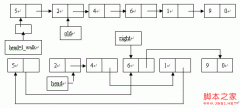STL组件之算法(1)
STL提供了大量的模板类和函数,可以在OOP和常规编程中使用。所有的STL的大约50个算法都是完全通用的,而且不依赖于任何特定的数据类型。下面的小节说明了三个基本的STL组件:
1)迭代器提供了访问容器中对象的方法。例如,可以使用一对迭代器指定list或vector中的一定范围的对象。迭代器就如同一个指针。事实上,C++的指针也是一种迭代器。但是,迭代器也可以是那些定义了operator*()以及其他类似于指针的操作符地方法的类对象。
2)容器是一种数据结构,如list,vector,和deques ,以模板类的方法提供。为了访问容器中的数据,可以使用由容器类输出的迭代器。
3)算法是用来操作容器中的数据的模板函数。例如,STL用sort()来对一个vector中的数据进行排序,用find()来搜索一个list中的对象。函数本身与他们操作的数据的结构和类型无关,因此他们可以在从简单数组到高度复杂容器的任何数据结构上使用。
函数和函数对象
STL中,函数被称为算法,也就是说它们和标准C库函数相比,它们更为通用。STL算法通过重载operator()函数实现为模板类或模板函数。这些类用于创建函数对象,对容器中的数据进行各种各样的操作。下面的几节解释如何使用函数和函数对象。
函数和断言
经常需要对容器中的数据进行用户自定义的操作。例如,你可能希望遍历一个容器中所有对象的STL算法能够回调自己的函数。例如
- #include <iostream.h>
- #include <stdlib.h> // Need random(), srandom()
- #include <time.h> // Need time()
- #include <vector> // Need vector
- #include <algorithm> // Need for_each()
- #define VSIZE 24 // Size of vector
- vector<long> v(VSIZE); // Vector object
- // Function prototypes
- void initialize(long &ri);
- void show(const long &ri);
- bool isMinus(const long &ri); // Predicate function
- int main()
- {
- srandom( time(NULL) ); // Seed random generator
- for_each(v.begin(), v.end(), initialize);//调用普通函数
- cout << "Vector of signed long integers" << endl;
- for_each(v.begin(), v.end(), show);
- cout << endl;
- // Use predicate function to count negative values
- //
- int count = 0;
- vector<long>::iterator p;
- p = find_if(v.begin(), v.end(), isMinus);//调用断言函数
- while (p != v.end()) {
- count++;
- p = find_if(p + 1, v.end(), isMinus);
- }
- cout << "Number of values: " << VSIZE << endl;
- cout << "Negative values : " << count << endl;
- return 0;
- }
- // Set ri to a signed integer value
- void initialize(long &ri)
- {
- ri = ( random() - (RAND_MAX / 2) );
- // ri = random();
- }
- // Display value of ri
- void show(const long &ri)
- {
- cout << ri << " ";
- }
- // Returns true if ri is less than 0
- bool isMinus(const long &ri)
- {
- return (ri < 0);
- }
所谓断言函数,就是返回bool值的函数。
函数对象
除了给STL算法传递一个回调函数,你还可能需要传递一个类对象以便执行更复杂的操作。这样的一个对象就叫做函数对象。实际上函数对象就是一个类,但它和回调函数一样可以被回调。例如,在函数对象每次被for_each()或find_if()函数调用时可以保留统计信息。函数对象是通过重载 operator()()实现的。如果TanyClass定义了opeator()(),那么就可以这么使用:
- TAnyClass object; // Construct object
- object(); // Calls TAnyClass::operator()() function
- for_each(v.begin(), v.end(), object);
STL定义了几个函数对象。由于它们是模板,所以能够用于任何类型,包括C/C++固有的数据类型,如long。有些函数对象从名字中就可以看出它的用途,如plus()和multiplies()。类似的greater()和less-equal()用于比较两个值。
注意
有些版本的ANSI C++定义了times()函数对象,而GNU C++把它命名为multiplies()。使用时必须包含头文件<functional>。
一个有用的函数对象的应用是accumulate() 算法。该函数计算容器中所有值的总和。记住这样的值不一定是简单的类型,通过重载operator+(),也可以是类对象。
Listing 8. accum.cpp
- #include <iostream.h>
- #include <numeric> // Need accumulate()
- #include <vector> // Need vector
- #include <functional> // Need multiplies() (or times())
- #define MAX 10
- vector<long> v(MAX); // Vector object
- int main()
- {
- // Fill vector using conventional loop
- //
- for (int i = 0; i < MAX; i++)
- v[i] = i + 1;
- // Accumulate the sum of contained values
- //
- long sum =
- accumulate(v.begin(), v.end(), 0);
- cout << "Sum of values == " << sum << endl;
- // Accumulate the product of contained values
- //
- long product =
- accumulate(v.begin(), v.end(), 1, multiplies<long>());//注意这行
- cout << "Product of values == " << product << endl;
- return 0;
- }
编译输出如下:
- $ g++ accum.cpp
- $ ./a.out
- Sum of values == 55
- Product of values == 3628800
『注意使用了函数对象的accumulate()的用法。accumulate() 在内部将每个容器中的对象和第三个参数作为multiplies函数对象的参数,multiplies(1,v)计算乘积。VC中的这些模板的源代码如下:
- // TEMPLATE FUNCTION accumulate
- template<class _II, class _Ty> inline
- _Ty accumulate(_II _F, _II _L, _Ty _V)
- {for (; _F != _L; ++_F)
- _V = _V + *_F;
- return (_V); }
- // TEMPLATE FUNCTION accumulate WITH BINOP
- template<class _II, class _Ty, class _Bop> inline
- _Ty accumulate(_II _F, _II _L, _Ty _V, _Bop _B)
- {for (; _F != _L; ++_F)
- _V = _B(_V, *_F);
- return (_V); }
- // TEMPLATE STRUCT binary_function
- template<class _A1, class _A2, class _R>
- struct binary_function {
- typedef _A1 first_argument_type;
- typedef _A2 second_argument_type;
- typedef _R result_type;
- };
- // TEMPLATE STRUCT multiplies
- template<class _Ty>
- struct multiplies : binary_function<_Ty, _Ty, _Ty> {
- _Ty operator()(const _Ty& _X, const _Ty& _Y) const
- {return (_X * _Y); }
- };
引言:如果你想深入了解STL到底是怎么实现的,最好的办法是写个简单的程序,将程序中涉及到的模板源码给copy下来,稍作整理,就能看懂了。所以没有必要去买什么《STL源码剖析》之类的书籍,那些书可能反而浪费时间。』
(1)发生器函数对象
有一类有用的函数对象是“发生器”(generator)。这类函数有自己的内存,也就是说它能够从先前的调用中记住一个值。例如随机数发生器函数。
普通的C程序员使用静态或全局变量 “记忆”上次调用的结果。但这样做的缺点是该函数无法和它的数据相分离『还有个缺点是要用TLS才能线程安全』。显然,使用类来封装一块:“内存”更安全可靠。先看一下例子:
Listing 9. randfunc.cpp
- #include <iostream.h>
- #include <stdlib.h> // Need random(), srandom()
- #include <time.h> // Need time()
- #include <algorithm> // Need random_shuffle()
- #include <vector> // Need vector
- #include <functional> // Need ptr_fun()
- using namespace std;
- // Data to randomize
- int iarray[10] = {1, 2, 3, 4, 5, 6, 7, 8, 9, 10};
- vector<int> v(iarray, iarray + 10);
- // Function prototypes
- void Display(vector<int>& vr, const char *s);
- unsigned int RandInt(const unsigned int n);
- int main()
- {
- srandom( time(NULL) ); // Seed random generator
- Display(v, "Before shuffle:");
- pinter_to_unary_function<unsigned int, unsigned int>
- ptr_RandInt = ptr_fun(RandInt); // Pointer to RandInt()//注意这行
- random_shuffle(v.begin(), v.end(), ptr_RandInt);
- Display(v, "After shuffle:");
- return 0;
- }
- // Display contents of vector vr
- void Display(vector<int>& vr, const char *s)
- {
- cout << endl << s << endl;
- copy(vr.begin(), vr.end(), ostream_iterator<int>(cout, " "));
- cout << endl;
- }
- // Return next random value in sequence modulo n
- unsigned int RandInt(const unsigned int n)
- {
- return random() % n;
- }
编译运行结果如下:
- $ g++ randfunc.cpp
- $ ./a.out
- Before shuffle:
- 1 2 3 4 5 6 7 8 9 10
- After shuffle:
- 6 7 2 8 3 5 10 1 9 4
首先用下面的语句申明一个对象:
- pointer_to_unary_function<unsigned int, unsigned int>
- ptr_RandInt = ptr_fun(RandInt);
这儿使用STL的单目函数模板定义了一个变量ptr_RandInt,并将地址初始化到我们的函数RandInt()。单目函数接受一个参数,并返回一个值。现在random_shuffle()可以如下调用:
- random_shuffle(v.begin(), v.end(), ptr_RandInt);
在本例子中,发生器只是简单的调用rand()函数。
关于常量引用的一点小麻烦(不翻译了,VC下将例子中的const去掉)
- 上一篇:STL组件之迭代器(1)
- 下一篇:STL容器之向量vector容器





